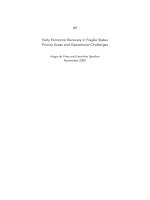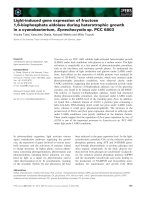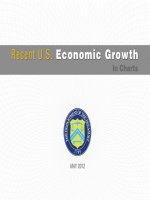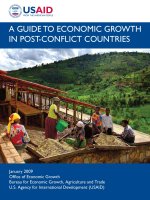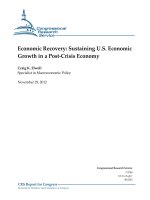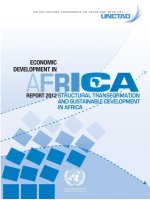Determinants of economic growth in a panel of asean and developing countries
Bạn đang xem bản rút gọn của tài liệu. Xem và tải ngay bản đầy đủ của tài liệu tại đây (1.14 MB, 69 trang )
UNIVERSITY OF ECONOMICS
INSTITUTE OF SOCIAL STUDIES
HO CHI MINH CITY
THE HAGUE
VIET NAM
THE NETHERLANDS
VIET NAM –THE NETHERLANDS PROGRAMME
FOR MASTER OF DEVELOPMENT ECONOMICS
----------------------------------
DETERMINANTS OF ECONOMIC
GROWTH IN A PANEL OF ASIA PACIFIC
COUNTRIES
FINAL THESIS
Supervisor: Nguyen Hoang Bao
Student: Tran Luu Quoc Vuong
Class: MDE-16
---------------------------------------------HO CHI MINH CITY, DECEMBER 2013
APPENDICES
A: List of chosen countries and territories in Asia Pacific Region
51
B: Scatterplot matrix of variables
52
C: Tests
53
LIST OF FIGURES
Figure 3.1. Conceptual framework of the study
14
Figure 4.1. Growth rate versus Level of Per capita GDP (simple relation)
27
LIST OF TABLES
Table 3.1 Summary of variables
20
Table 4.1. Summary Statistic on the sample observations
29
Table 4.2. Correlation on the sample observations
30
Table 4.3. Basic Cross-Country Growth Regression
31
Table 4.4. Heteroskedasticity – White test
32
Table 4.5. Basic Cross-Country Growth Regression (robust)
33
Table 4.6. Multicollinearity testing
34
Table 4.7. Restricted Model (1)
35
Table 4.8. Restricted Model (2)
36
Table 4.9. Model Comparison
37
Table 4.10. Extended models
43
ABBREVIATIONS
IMF
:
International Monetary Fund
WB
:
World Bank
UN
:
United Nations
GDP
:
Gross Domestic Products
GNP
:
Gross National Products
R&D
:
Research and Development
OECD
:
The Organization for Economic Co-operation and Development
Table of Contents
1.
2.
3.
4.
CHAPTER 1: INTRODUCTION ..........................................................................2
1.1.
Problem statement ......................................................................................................... 2
1.2.
Objectives of study........................................................................................................ 3
1.3.
Research questions ........................................................................................................ 4
1.4.
Scope of the research .................................................................................................... 4
1.5.
Structure of the thesis .................................................................................................... 4
CHAPTER 2: THEORETICAL AND EMPIRICAL BACKGROUND ..................6
2.1.
Theoretical background:................................................................................................ 6
2.2.
Empirical review ........................................................................................................... 9
2.3.
Summary ..................................................................................................................... 12
CHAPTER 3: RESEARCH METHODOLOGY .................................................. 13
3.1.
Conceptual framework ................................................................................................ 13
3.2.
Variables ..................................................................................................................... 14
3.2.1
Dependent variables ............................................................................................ 14
3.2.2
Explanatory variables .......................................................................................... 15
3.3.
Data ............................................................................................................................. 22
3.4.
Econometric model ..................................................................................................... 22
3.5.
Summary ..................................................................................................................... 24
CHAPTER 4: DATA ANALYSIS .......................................................................26
4.1.
Growth rate and convergence...................................................................................... 26
4.2.
Descriptive analysis .................................................................................................... 27
4.3.
Regression Results for Growth rates ........................................................................... 30
4.3.1
Basic Regression ................................................................................................. 30
4.3.2
Hypothesis tests ................................................................................................... 32
4.3.3
The Determinants of Growth rate........................................................................ 39
4.3.4
The extended models........................................................................................... 42
4.4.
Summary ..................................................................................................................... 44
Determinants of economic growth in a panel of Asia Pacific countries
5.
6.
Thesis Proposal
CHAPTER 5: CONCLUSION AND POLICY IMPLICATIONS ........................ 45
5.1.
Main findings and policy implications ........................................................................ 45
5.2.
Limitation of the research and Recommendation for further studies .......................... 45
REFERENCES.....................................................................................................48
Tran Luu Quoc Vuong – MDEk16
1
Determinants of economic growth in a panel of Asia Pacific countries
Thesis Proposal
1. CHAPTER 1: INTRODUCTION
1.1. Problem statement
Nowadays, there are over 200 countries on over the world with different
institutions, with different growth rates. These growth rates vary hugely across
countries and between developing countries to developed countries. According to
recent surveys of many international organizations (IMF, WB, UN and so on), developing countries and economies in transition continue to register much stronger
growth than developed economies.
After the end of the World War II, the world started to recover economic
and the growth became an important part of economic science. Economists have
tried to apply other theories with a lot of empirical model to understand the process
of economic growth and explain enormous differences in economic performance
across countries. In the early, economists used Keynesian theories to discuss about
the stability of the growth path. Next, they focused on steady state growth rates
exogenously determined by technological progress. After that, Solow (1956) and
Swan (1956) became the pioneers who enriched neoclassical economic growth
model, and followed by a lot of others. From 1980s, economists developed growth
theory, which use endogenous economic growth model to evaluate the roles of
knowledge, innovation and human capital.
Improvements of economic theories and hundreds of researches have provided acceptable explanation for a particular phenomenon of recent decades: the
great divergence in economic performance. But, indeed, the income of underdeveloped economies, as a whole, are failing to catch up the income of the developed
countries. Realizing this inadequacy, economic growth studies have shifted their
focus to find out the reason of this problems.
There were a lot of researches discuss about this problem, such as: Solow
(2000), Aghion and Howitt (1998), Kenny and Williams (2001), Temple (1999),
Tran Luu Quoc Vuong – MDEk16
2
Determinants of economic growth in a panel of Asia Pacific countries
Thesis Proposal
Bosworth and Collins (2003) and Rogers (2003). They identified main contributions to the recent growth literature, especially relevant institution factors. The
main objects these economists aimed were developing countries in the Asian Pacific area. They wanted to understand how recent developments in the growth literature contribute to economic development of Asian Pacific countries.
In this study, the research examine the relationship between per capita
growth rate to a set of quantifiable explanatory variables with a conditional convergence term: the growth rate rise when the initial level of real per capita GDP is
low relative to the staring human capital and for given values of other policies,
institutions and national characteristic variables. This research will use panel data
of 25 countries and territories of Asian Pacific region for the period of 1990 - 2010.
This study use panel data approach and apply three-stage less squared regression to examine the determinants of the growth rate. The regression, which
uses panel data, has many advantages with regards to typical cross-country regression that was advanced by Raftery (1995), Sala-i-Martin et al. (2004). First, using
panel data, we will eliminate constraint by limited number of countries available.
Second, this method allows addressing the inconsistency of empirical estimates.
This inconsistency appears with omitted country-specific effects correlated with
other regressors, or with endogenous variables which assumed to be exogenous.
1.2. Objectives of study
This research will examine the relationship between per capita growth rate
and a set of quantifiable explanatory variables: human capital (education and
health), policies, institution and national characteristics. From empirical studies,
for given initial levels of state variables (including physical and human capital),
the economic growth rates have positive relation to the rule of law, the investment
ratio and negative relation to the fertility rate, the ratio of government consumption
to GDP and the inflation rate. In the case of the terms of trade and the extent of
Tran Luu Quoc Vuong – MDEk16
3
Determinants of economic growth in a panel of Asia Pacific countries
Thesis Proposal
international openness, with fair movements, the growth will increase but the latter
effect is surprisingly weak.
The research will define which factors affect to the growth rate of Asian
Pacific developing countries, including Vietnam. It also extend to evaluate some
special countries, which have huge population size, such as: China, India; or developed countries, such as Japan, Australia, Singapore and so on
1.3. Research questions
This research aims at answering the following questions:
The relationship between per capita growth rate and a set of quantifiable
explanatory variables? Which variables are significant ones to economic
growth?
Intensity of impact of these factors to economic growth of the Asia Pacific
region?
1.4. Scope of the research
The research focuses on examine the convergence hypothesis implies that
the growth rate of real per capita GDP would tend to be inversely related to the
level of initial real per capita GDP, and the role of a set quantifiable explanatory
variables. The chosen countries are 25 countries in Asian Pacific region, and some
special countries which have huge population size (China, India) or specific characteristics (Japan, Singapore). This research only examines in the period of 1985 2010 because lacking of GDP data before 1980 for all countries in this region.
1.5. Structure of the thesis
The research will be organized with five chapters. The chapter one has
structure as above: explain the reason why we choose this topic, identify the problems that the research need to examine with some major research questions and
the scope of the research. The rest of this research has four chapters. Chapter two
Tran Luu Quoc Vuong – MDEk16
4
Determinants of economic growth in a panel of Asia Pacific countries
Thesis Proposal
shows a brief view of theoretical background of growth model, from the neoclassical growth models to the endogenous growth models, and the role of trade and
institutions on the growth rate as well. A review of empirical studies makes clearly
about results of different models when applying to explain recent developments.
In chapter three, we will highlight the research methodology, including conceptual framework and variable descriptions. We will have a briefly discussion
about the reason why we choose these variables, how to enter them into the equations after introducing the general econometrics model. Besides, the process outline which we use to analyze data, is also mentioned in this chapter. Chapter four
will show the regression results of the models. We will analyze and get findings to
answer the questions in the chapter 1. We also compare findings to results of other
empirical studies. And at chapter five, we resumes main findings and reevaluate
factors which have significant influence to growth rate of an economy. This chapter also identifies the limitation and implications for further study.
Tran Luu Quoc Vuong – MDEk16
5
Determinants of economic growth in a panel of Asia Pacific countries
Thesis Proposal
2. CHAPTER 2: THEORETICAL AND EMPIRICAL BACKGROUND
2.1. Theoretical background:
In the 1950s, growth theory was composed mainly of the neoclassical
model, developed by Ramsey (1928), Solow (1956), Swan (1956), Cass (1965)
and Koopmans (1965). One feature of this model is the convergence property with
the characteristic of diminishing returns to capita in a closed economy, where technological progress is assumed to be exogenous and there are same technical opportunities across countries. This theory said that, the predicted growth rate will
higher with the lower starting level of real per capita gross domestic product.
If all economies were naturally the same, except for their starting capital
intensities, the convergence would apply in an absolute sense; it means that, poorer
economies typically grow faster per capita and tend thereby to catch up to the
richer economies. However, if they differ from a lot of factors, such as rate of birth,
willingness to work, technology accessing, government policies, the convergence
force applies only in a conditional sense. The predicted growth rate will be higher
if the starting level of per capita GDP is low in relation to its long–run (steady
state) position. For example, a poor country would not tend to grow rapidly if it
also has a low long–term position which possibly because its public policies are
unfavorable or its saving rate is low.
But along the time has been changing, this model showed its own limitation.
So, a new wave rose in economic growth theory. Growth theorists of 1960s assumed that technological progress is exogenous to the growth rate, will make the
economy temporarily grows in short term but not in long term. But, unfortunately,
while endogenous factors, like as the saving rate and population growth, determine
the steady state or ceteris paribus of an economy, the technological progress decides the growth rate of the steady state. Thus, we can use model of growth to
explain everything but long-run growth.
Tran Luu Quoc Vuong – MDEk16
6
Determinants of economic growth in a panel of Asia Pacific countries
Thesis Proposal
And as a consequence, since the 1980s, the economic growth theory had a
new sense. Several variables treated as exogenous before became endogenous. The
Ramsey-Cass-Koopmans model endogenized the savings rate, and in consequence, the saving rate may not be constant along the transition to the long run
steady state. Other different assumptions, fertility was treated as endogenous in
researches of Galor and Weil (1996), Cigno and Rosati (1996) and Barro and
Becker (1989). Besides, in Solow – Swan model, the explicit consideration of human capital was not mentioned, and this absence motivated work on endogenous
growth theory and a series of idea-based model.
In the mid-1980s, a group of growth theorists dismissed the Solow-Swan
model because they did not satisfied with common accounts of exogenous factors
determining long-run growth. They were interested in the endogenous growth
model that assumes constant and increasing returns of capital and replace the exogenous growth variable with explicit key determinants. The researches were done
by Paul Romer (1986), Lucas (1988) and Rebelo (1991) are initial researches of
the new wave. Instead of technological change, growth in these models was caused
by indefinite investment in human capital in the forms of education, experience,
and health and reduced the diminishing return to capital accumulation.
Using the existence of R&D theories and imperfect competition, Romer
(1990), Grossman and Helpman (1991) presented positive externalities of human
capital accumulation and found that the gap between the marginal value of an additional unit of human capital and the market wage. Moreover, from the results of
researches which applied endogenous growthe model (Romer 1986, 1989, 1990;
Lucas 1988; Rebelo 1991; Grossman and Helpman 1991; Aghion and Howitt
1992), there was evidences to prove that the growth rates can be permanently
changed by variables which affected by government policies. In these papers, the
variables which used as factors can affect the long-term growth rate are taxation,
rule of law, infrastructure services and other financial institutions. So, the government plays an important in affecting the long-term rate of growth.
Tran Luu Quoc Vuong – MDEk16
7
Determinants of economic growth in a panel of Asia Pacific countries
Thesis Proposal
Another factors have important impact to the economic growth are trade
and international trade. Different for Solow-Swan model, which is for closed economies, the extended neoclassical growth models show that opening an economy
can temporarily increase the growth rate. In the endogenous growth models, openness to international trade can give different results. Through various channels,
such as: learning-by-doing, specialization and spillovers, knowledge transfers,
R&D and scale effect, economic performance will have explicit enhancement.
However, the impact of trade on growth can be positive or unclear, different across
countries, depending on their characteristics.
But, the neoclassical growth models and the endogenous growth models can
not address the fundamental driving forces of growth, and hence, cannot explain
the enormous variation in economic performance across countries over time. Recent decades, poorer countries have failed to grow faster than high-income countries, and the Solow-Swan type of growth model cannot explain by using convergence concept. The endogenous growth model can provide an explanation for both
questions: why higher income per capita countries can grow fast or faster than
lower income per capita ones; and why larges countries may grow faster due to
scale effects. However, in the case of under-developed economies, this model still
cannot explain the difference in economic performances.
Along with the development of the endogenous growth model, new inquiry
was been revealed with the proliferation of literature on imperfect information, the
existence of transaction cost, incomplete market functions, and the role of government and institutions. Especially, the role of institutions and institutional change
in economic growth became one of important topic of growth literature (Hodgson
1988, 1994, 1998; Eggertsson 1990; North 1989, 1999; Olson 1982, 1996, 2000;
Olson et al. 2000). They argued that the differences in the quality of nations’ institutions and economic policies are results of the differences in the wealth of those
nations.
Tran Luu Quoc Vuong – MDEk16
8
Determinants of economic growth in a panel of Asia Pacific countries
Thesis Proposal
There were a lot of argument about “what is the definition of institution?”,
but they can be summarized into two definitions. The first equates institutions to
the rule of the game, establishing the baseline conditions for other actions: property
rights, the role of formal law, culture, human behavior and individual decision
making. The second concentrates on governing structures, in which firms, organizations and designations of other kinds are referred to as institutions, like financial
institutions and labor market institutions. According to the theory of institutional
economics, the ‘exchange’ concept is not only an exchange of physical products
or material services, but also is the transfer of two ownerships. Therefore, institutions become an important factor which evaluates market efficiency. So, countries
with better institutions will organize and use resources more efficiently to achieve
a higher level of income.
2.2. Empirical review
Identifying the determinants of economic growth has always been one of
most important concern of the growth literature. Since 1980s, there were a lot of
empirical researches, using both neoclassical and endogenous growth theories, to
identify the sources of growth. And there is a consensus among economists that
economic growth is determined by a number of sources – physical capital, human
capital and knowledge.
Using data of 98 countries in the period 1960-1985, Barro (1991) applied
cross-sectional framework to examine the determinants of these economies. The
research showed that while the initial level of real per capita GDP negative affect
to the growth rate of real per capita GDP, the initial human capital would boost the
growth rate higher. Additional, human capital positively affects to the ratios of
physical investment to GDP while having negatively impact to the fertility rates.
The share of government consumption in GDP will lead the growth rate slower,
but the effect of the share of public investment to the growth is not clear. Measures
Tran Luu Quoc Vuong – MDEk16
9
Determinants of economic growth in a panel of Asia Pacific countries
Thesis Proposal
of political stability has positive influence to the growth rate while proxy for market distortions inverts.
In another research with panel data of around 100 countries from 1960 to
1990 (1996), Barro reevaluated the role of human capital in the form of education
and health to the economic growth of a countries. He emphasized the relationship
between physical capital and human capital: the faster the economy growths, the
greater its current level of human capital develops. Later, Sachs and Warner (1997)
used cross-country regression model to evaluate the economic growths of African
countries during the period 1965 – 1990. They found that poor economic policies
play an important role in the slow growth of these countries, especially, these countries lack of openness of international trade. They also argued that if the countries
has faster growth in human capital, these countries will have faster transitional
growth. Gallup et al. (1998) had a further conclusion. He said that the countries
which has a developed labor force will be more efficient in using resources than
others countries. Nelson and Phelps (1966), Romeo (1990), Levine and Zervos
(1993), Brunetti et al. (1998), Martin and Xavier (1997) also had researches identifying the role of human resource in absorbing and applying knowledge, technology into the economic growth.
In the same research in 1996, Barro also extended Barro and Lee (1993) to
include two factors as political instability variables: the rule of law index and the
index of democracy. Similar with above research, Barro got the same results:
growth is negatively related to the initial level of real per capita GDP, fertility,
government consumption and inflation; but positively related to initial schooling
and life expectancy, improvement in the terms of trade. At the same time, he obtained some new information: Effect of political freedom to the economic growth
is weak, but this effect could be nonlinear with some unclear signs. Similarly, the
democracy also have weak effect on growth. On the contrary, the standard of living
on a country’s propensity have strong and positive impact to experience democracy.
Tran Luu Quoc Vuong – MDEk16
10
Determinants of economic growth in a panel of Asia Pacific countries
Thesis Proposal
Also focusing on political issues, Mauro (1995), Knack and Keefer (1995)
and Alesina et al. (1996) have their own ways. By using subjective indexes originate from information collected by private monitoring organizations, they concurred that political instability have negative effects to investment and growth.
They also argued that subjective indexes of corruption and the quality of bureaucracy will have negative relation to the growth.
Using endogenous growth models, there were a lot of analysis has been
done by using economic rights (capital mobility, trade restrictions, property rights,
civil liberty and other indicators of economic regulations). Barro (1991), Ozler and
Rodrik (1992), De Haan and Sturm (2000) argued that if less regulations and fewer
obstacles should motivate faster growth rates and capital accumulation. Howerver,
according to Heckelman and Stroup (2000), Carlsson and Lundstruom (2002), the
effects of economic freedom on growth maybe vary across areas.
Besides, institutions has also become a new interest of economists with the
pioneers of Acemoglu et al. (2001, 2003), Rodrik et al. (2002) and Easterly and
Levine (2002). They found that institutions are the most important factors affecting
a country’s income. Furthermore, Acemoglu et al. (2001), Frankel and Romer
(1999), Rodrik et al. (2002) used institutions and integration as instruments and
stated that “the quality of institutions is the only positive and significant determinant of income levels”.
The growth effects of trade openness has also been confirmed by many empirical studies: Dollar (1992), Sachs and Warner (1995), Edwards (1998), Greenaway et al. (1998), Frankel and Romer (1999), Vamvakidis (2002)… The growth
effects of trade not only have been found via investment, human capital accumulation, and technology, but also by the quality of macroeconomic policy, government size and the extent of price distortions (Levine and Renelt 1992, Frankel and
Romer 1999, Wacziarg 2001).
Tran Luu Quoc Vuong – MDEk16
11
Determinants of economic growth in a panel of Asia Pacific countries
Thesis Proposal
Above results were updated in another results of Barro in 2003. He got the
same results as the research he completed in 1996 mentioned above. He found that
there is existences of condition convergence in the model: the growth rate would
rise when the initial level of real per capita GDP is low and depend on initial state
variables like human capitals in the forms of education and health, other institution
and national characteristic variables. The difference in the paper is that he using
panel data to approach the problems.
2.3. Summary
This chapter gives an overview on theoretical background, which shows us
empirically determinants of economic growth. From neoclassical models to endogenous growth models, and the role of institutions, theoretical economists have
try to identify which factors have significant impacts to the performance of an
economy. Although there are still a lot of problems but it is meaningful for policy
implications.
Tran Luu Quoc Vuong – MDEk16
12
Determinants of economic growth in a panel of Asia Pacific countries
Thesis Proposal
3. CHAPTER 3: RESEARCH METHODOLOGY
3.1. Conceptual framework
In this research, the panel data approach and averaging methodology is ap-
plied to measure the effect of quantifiable explanatory variables to the economic
growths. Growth rate of per capita GDP is used as economic growths while the
initial state of the economy is described by initial level of per capita GDP and
initial human capital in the form of education attainment and health. Moreover,
some variables that reflect policies, institutions and national characteristics, such
as investment ratio (Knight, Loayza and Villanueva, 1992; Sala-i-Martin, 1995;
Barro, 2003), international openness (Dollar, 1992; Sachs and Warner, 1995; Edwards, 1998; Frankel and Romer, 1999; Vamvakidis, 2002; Baldwin, 2003; López,
2005), fertility rate (Barro, 1995, 2003; ), the ratio of government consumption
(Barro, 1995, 2003; X. Sala-i-Martin; ) and the inflation rate (S. Fischer, 1993;
Barro, 1995, 2003; ) are concluded in the model to explain the impact of conditional convergence term. The reasons why these variables are chosen, mentioning
specifically in the part 3.2 of this chapter (data and variables).
The framework that we are considering to choose model for regressions as
below:
Tran Luu Quoc Vuong – MDEk16
13
Determinants of economic growth in a panel of Asia Pacific countries
Thesis Proposal
Figure 3.1: Conceptual framework of the study
-
-
State Variables
Initial per capita GDP
Initial human capital
Education
Health
Policy Variables &
National Characteristics
International Openness
Government Consumption
Fertility
Investment
Inflation
Panel Data Approach
Averaging Methodology
with lagging instruments
-
Economic
Growth
Instrument Variables
Initial per capita GDP
Government Consumption
Investment
International Openness
3.2. Variables
3.2.1 Dependent variables
This research uses per capita GDP as dependent variables. It is the ratio of
GDP to population, a measurement of how prosperous a country feels to each
of its citizens and a growth in per capita GDP is referred to as intensive growth.
In comparison with GDP, per capita GDP is widely assumed to be a better indicator to evaluate level of development of a country. By using this variable,
we can also compare the prosperity of countries with different population size.
There are some reasons for using per capita GDP instead of GDP (or GNP).
First, GDP only counts money transaction, does not count many goods provided for free. It means that, GDP does not reckon contributions of crucial economic functions in the household and volunteer sectors. It can be a serious
problem when examining the economies of the less-developed nations where a
lot of economic activities take place in household sectors.
Tran Luu Quoc Vuong – MDEk16
14
Determinants of economic growth in a panel of Asia Pacific countries
Thesis Proposal
The second reason, GDP overlooks everything that occurs outside the
realm of monetized exchange, regardless of the importance to well-being. Cobb
et al. stated that it likes a business that kept a balance sheet by adding all transaction, not care they are income or expenses, assets or liabilities. Moreover,
GDP calculation violates accounting principles when treating depletion of natural capital as current income, but capital depreciation. And the last problem,
the GDP totally ignores the distribution of income, different from per capita
GDP.
In this research, we will examine the relationship between the growth rate
and other factors for each ten-year period: 1990-2000 and 2000-2010.
3.2.2 Explanatory variables
a. Initial per capita GDP
According to empirical analysis, a lot of growth theorists has stated that
the growth rate of per capita GDP would tend to be inversely related to the
initial per capita GDP for given determinants of GDP (Barro, 1991, 1995, 2004;
Sala-i-Martin, 1995). In this research, we will inspect the growth rate for 2 tenyear periods (1990-2000 and 2000-2010). Besides, we will use earlier values
in 1985 and 1995 as instruments to diminish the tendency of overestimation of
the convergence rate because of temporary measurement error in GDP.
The initial level of per capita GDP enters into the growth equation in the
form log(yt−1) so that the coefficient on this variable represents the rate of convergence, that is, the responsiveness of the growth rate, D yt, to a proportional
change in yt−1. Because it have inverse ration to the growth rate as convergence
hypothesis, this variable was expected to have negative sign.
b. Educational attainment
Tran Luu Quoc Vuong – MDEk16
15
Determinants of economic growth in a panel of Asia Pacific countries
Thesis Proposal
In this research, we use education attainment and health to measure human
capital, one of two state variables. And in turn, to measure the education attainment, school enrollment rates are chosen: primary-school enrollment rate and
secondary-school enrollment rate.
Hanushek and Kimko (2000) suggested that we should us traditional
schooling or primary or secondary-school enrollment rate variables to evaluate
the quality of labor force, and emphasize the role of human capital in further.
As microeconomic analysis, it is often to find that schooling has a significant
impact on productivity and wage earnings.
Similarly to initial level of per capita GDP, we enter the figures in 1990
and 2000 to growth equations for 2 periods, respectively. This variable expect
to have positive sign.
c.
Life expectancy
As one of measurements of human capital, the reciprocal of life expectancy
at age one is used as a proxy in the basic system. If the probability of dying
were independent of age, then this reciprocal would give the probability per
year of dying.
From 1940s, by the rise of the wave of international health innovations and
improvements, life expectancy became an important factor of demographic science. From an estimation of mortality by disease before the 1940s using data
source from the League of Nations, the authors found that the life expectancy
have a significant affect to population but much smaller affect to economic
growth. Daron Acemoglu and Simon Johnson (2006) consist of 59 countries,
from Western Europe, Oceania, the Americas and Asia during the period 19401980 to measure the impact of the health of the population on economic growth.
They found that the impact of life expectancy on per capita GDP are not clear
Tran Luu Quoc Vuong – MDEk16
16
Determinants of economic growth in a panel of Asia Pacific countries
Thesis Proposal
and differ across countries, depending on the investment rate. The life expectancy have small positive effect to economic growth in initial period, but not
enough to compensate for the increase in population.
With the same interest, David de la Croix and Omar Licandro (1999) examined the relationship between life expectancy and endogenous growth. They
stated that “the effect of life expectancy on growth is positive for economies
with a relatively low life expectancy, but could be negative in more advanced
economies.” So, from above argument, the expected sign of this variables to
economic growth is not clear.
d. Fertility rate
Similarly to life expectation, the fertility rate is also a measure of human
capital. It have an important role on increasing population growth, which has a
negative effect on the steady-state of capital in the neoclassical growth model.
So, there is a prediction that the fertility rate would have a negative relationship
to the growth rate.
Barro and Sala-i-Martin (1995) using data of around 100 countries and
found the negative relationship between fertility rate and the growth rate. They
argued that higher fertility rate the economy has, the higher population growth
is. Moreover, female primary education has a strong negative relation with fertility rate. This result is the same to other researches (Schultz, 1989; Behrman,
1990; Barro and Lee, 1994; Quamrul H. Ahraf, David N. Weil and Joshua
Wilde, 2012). Another reason Barro stated is that higher fertility also requires
greater resources devoted to childrearing, and as consequence, reduce the economic growth.
The expected sign of this variables to economic growth is negative.
e.
Government consumption ratio
Tran Luu Quoc Vuong – MDEk16
17
Determinants of economic growth in a panel of Asia Pacific countries
Thesis Proposal
In the neoclassical growth model, the long-run growth rate is independent
of government policy, but in the endogenous growth model, the role of government has changed. In Barro (1991), there are the presence of constant returns
to capital, including private capital and public services. He found that there is
a significant negative affect on growth from the ratio of government consumption to GDP; and, big government is bad for growth.
And there are several studies have examined this conclusion. Landau
(1983) showed evidence of a negative relationship between the growth rate (per
capita GDP) and the share of government consumption expenditure in GDP by
inspecting data of over 100 countries in the period 1961-1976. Grier and
Tullock had a same conclusion after using data of 115 countries in their study
which extended the Kormedi and Meguire (1985) form. Barth and Bradley
(1987) found a same result for 16 OECD countries in the period 1971-1983.
f.
International openness
The relationship between international openness and economic growth is
one of oldest issues in economics. Trade openness and growth has complicated
relationship (Yanikkaya, 2003). In the extended neoclassical growth model,
opening an economy can help the economy to temporarily increase the growth
rate (Srinivasan and Bhagwati, 1980). In the newer model, endogenous growth
model, the role of international openness has changed when the theories said
that openness facilitates the transmission of technology from other countries
(Lucas 1988, Young 1991), direct resources toward other more research intensive sectors (Grossman and Helpman, 1991) and increase market size (RiveraBatiz and Romer, 1991). However, the overall impact of trade on growth can
be positive or not clear, depending on the models and national characteristics:
tariffs and trade restrictions.
The explanatory variable includes a measure of the extent of international
openness, calculated by the ratio of exports plus imports to GDP.
Tran Luu Quoc Vuong – MDEk16
18
Determinants of economic growth in a panel of Asia Pacific countries
Thesis Proposal
g. Investment ratio
In recent growth model, investment has been one of main factors using to
explain economic growth. Young (1994) concluded that “investment was the
main source of growth in the experience of the East Asian economies”. Others
have found that there are a positive correlation between growth and investment
(Kahn and Kumar, 1997; Kahn and Reinhart, 1990; Serven and Solimano,
1992; Greene and Villanueva, 1991).
In neoclassical growth model, the economy is closed. So, the saving rate is
exogenous and equal to the ratio of investment. In this research, the effect of
the saving rate is measured empirically by the ratio of real investment to real
GDP. And, because of the effect of the saving rate on growth, in this case, we
will use lagged values, the lagged investment ratio, as instruments to enter to
the basic equation.
The expected sign of this variables to economic growth is positive.
h. Inflation rate
There are a lot of different conclusions about the relationship between the
growth and inflation. In neoclassical growth model, technological change became the primary factor explaining long-term growth and was assumed to be
exogenous, that is, to be independent of all other factors, including inflation
(Todaro, 2000). Mundell (1963) used his model to state the negative relationship between inflation and people’s wealth. So, people have to increase saving
to get desired wealth and leading to faster output growth. Sidrauski (1967) proposed the next major development. The main result of Sidrauski is that the inflation rate does not affect the steady state capital stock, output and economic
growth.
Stockman (1981) developed a new model in which money is a compliment
to capital. In this model, there was a negative relationship between the steadystate level of output and inflation rate. Cooley and Hansen (1989) extended the
Tran Luu Quoc Vuong – MDEk16
19
Determinants of economic growth in a panel of Asia Pacific countries
Thesis Proposal
mechanism with regards to capital accumulation. They showed that increase in
inflation rate leads the level of output permanently fall.
In endogenous growth model, the growth rate depends on the rate of return
on capital. So, inflation decrease that rate, which in turn reduces capital accumulation and decrease the growth rate. And, when this model is set within moneytary exchange framework, the inflation rate lowered both the return on all
capital and the growth rate (Lucas 1980, Lucas and Stokey 1987, McCallum
and Goodfriend 1987)
In this research, we predict that the inflation has a negative relationship to
the growth rate. Inflation rate will be enters into the basic system in the form
of the average inflation rate, and used as a measure of macroeconomic stability.
Table 3.1. Summary of variables:
ExVariables
Description
pected
Main empirical reference
sign
GDP_Growth Growth of per capita
Init_GDP
Barro (1995, 1997, 2003), Bülent
GDP
Ulaşan (2012)
The initial level of per
Lucas (1988), Rebelo (1991), Caballe
capita GDP
and Santos (1993), Mulligan and
-
Sala-i-Martin (1993), Barro and Salai-Martin (1995), Barro (2003), Nelson and Phelps (1966), Ben habib and
Spiegel (1994)
Education at- - Primary-school entainment
rollment rate
Tran Luu Quoc Vuong – MDEk16
+
Barro (1991, 1995), Hanushek and
Kimko (2000)
20
Determinants of economic growth in a panel of Asia Pacific countries
Thesis Proposal
- Secondary-school
enrollment rate
Life
Expec- the reciprocal of life
tancy
expectancy at age one
Barro (2003),Daron Acemoglu and
+/-
Simon Johnson (2006), David de la
Croix and Omar Licandro (1999)
Fertility
The fertility rate
Barro and Sala-i-Martin (1995),
-
Barro (2003), Quamrul H. Ahraf, David N. Weil and Joshua Wilde (2012)
Gov_share
the ratio of govern-
Barro (1991, 1995), Sala-i-Martin
ment consumption to
(1995), Landau (1983), Grier and
GDP
-
Tullock
(1987),
Kormedi
and
Meguire (1985), Barth and Bradley
(1987)
Openness
the extent of interna-
Yanikkaya (2003), Barro (1995), Lu-
tional openness
cas (1988), Young (1991), Rivera+/-
Batiz and Romer (1991), Grossman
and Helpman (1991), Coe and Helpman (1995), Bülent Ulaşan (2012)
Investment
the ratio of real gross
Sala-i-Martin (1995), Barro (1995,
domestic investment
1997, 2003), M. Knight, N. Loayza
to real GDP
+
and D. Villanueva (1992), Kahn and
Kumar (1997), Kahn and Reinhart
(1990), Serven and Solimano (1992),
Greene and Villanueva (1991)
Tran Luu Quoc Vuong – MDEk16
21
